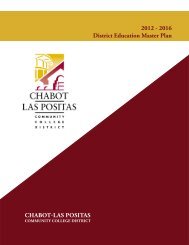City College of San Francisco - California Competes
City College of San Francisco - California Competes
City College of San Francisco - California Competes
Create successful ePaper yourself
Turn your PDF publications into a flip-book with our unique Google optimized e-Paper software.
THEME IV<br />
requirements necessary to achieve the cost center plans; and (5) the Assessment component, which<br />
includes Mid-Year and End-<strong>of</strong>-Year Assessment Reports, and an annual <strong>College</strong> Performance Indicators<br />
Report. In addition, the <strong>College</strong> publishes an annual Management Plan, the compilation <strong>of</strong> the cost center<br />
plans and budgets, the annual plan and the <strong>College</strong> budget. The Management Plan is a source document<br />
and reference for the <strong>College</strong> during the fiscal year.<br />
These five components <strong>of</strong> the <strong>College</strong>’s Planning and Budgeting System are fully integrated into the<br />
<strong>College</strong>’s Shared Governance System, and, with the leadership <strong>of</strong> the Chancellor, all <strong>College</strong> constituencies<br />
participate in the development and review <strong>of</strong> planning objectives and budgets. The Planning and<br />
Budgeting Council (PBC) is the key <strong>College</strong> Shared Governance committee charged with providing guidance<br />
within the overall planning system. The Board <strong>of</strong> Trustees is ultimately responsible for approval<br />
and adoption <strong>of</strong> both the plans and budgets. In addition, the Chancellor and the Board <strong>of</strong> Trustees also<br />
contribute to the planning process, monitor implementation, and assess results and outcomes.<br />
Improving and supporting student learning is the central focus <strong>of</strong> this system. Several features <strong>of</strong><br />
the <strong>College</strong>’s planning and assessment process focus upon program and service improvements. During<br />
the review and discussion within the strategic planning process, improvement issues are identified and<br />
discussed. When the objectives for the annual plan are discussed and identified during the fall semester,<br />
improvement issues are part <strong>of</strong> the conversation, as they can be again when the cost center plans and<br />
objectives are developed in the spring semester. Finally, the Mid-Year and End-<strong>of</strong>-Year Assessment Reports,<br />
as well as the annual <strong>College</strong> Performance Indicators Report, provide opportunities for discussion <strong>of</strong><br />
progress toward goals.<br />
Faculty, Staff, Administrative, and Student Initiatives. Not all significant improvement initiatives originate<br />
within the formal Planning and Budgeting System. CCSF is evolving toward a more self-reflective and<br />
keenly focused organizational culture. The institutional emphasis on planning has been an enabling factor<br />
promoting initiatives to improve programs and services. Consequently, there are increasing numbers <strong>of</strong><br />
faculty, staff, administrative, and student initiatives that must be addressed by the Planning and Budgeting<br />
System. At times, initiatives <strong>of</strong> this kind may involve a non-periodic (that is, unscheduled) review, study,<br />
or evaluation <strong>of</strong> the current situation and options for improvement.<br />
This essay covers four case studies in depth: (1) the Admissions and Records case study; (2) the Financial<br />
Aid case study; (3) the Architecture case study, perhaps the most traditional <strong>of</strong> all four in terms <strong>of</strong> the<br />
Department's effective use <strong>of</strong> Program Review, but also demonstrating elements <strong>of</strong> initiative; and (4) the<br />
Noncredit ESL Promotion Testing case study, an example <strong>of</strong> a faculty-led improvement initiative. It starts<br />
by examining the first two, which are examples <strong>of</strong> how non-periodic evaluations may be used at CCSF<br />
to jumpstart and accelerate the rate <strong>of</strong> improvement when there are compelling reasons to do so.<br />
III. Case Studies<br />
Admission and Records Re-Engineering Study: Visualizing New Realities. Efforts to improve processes<br />
related to admissions, registration, enrollment, and records at CCSF have been ongoing for many years.<br />
Incremental changes typically consisted <strong>of</strong> refining or modernizing processes and, from time to time,<br />
implementing new technology. In 2002, senior administration saw the need to further improve<br />
organizational effectiveness, particularly in the four areas <strong>of</strong> Human Resources/Personnel, Payroll,<br />
296 CITY COLLEGE OF SAN FRANCISCO







